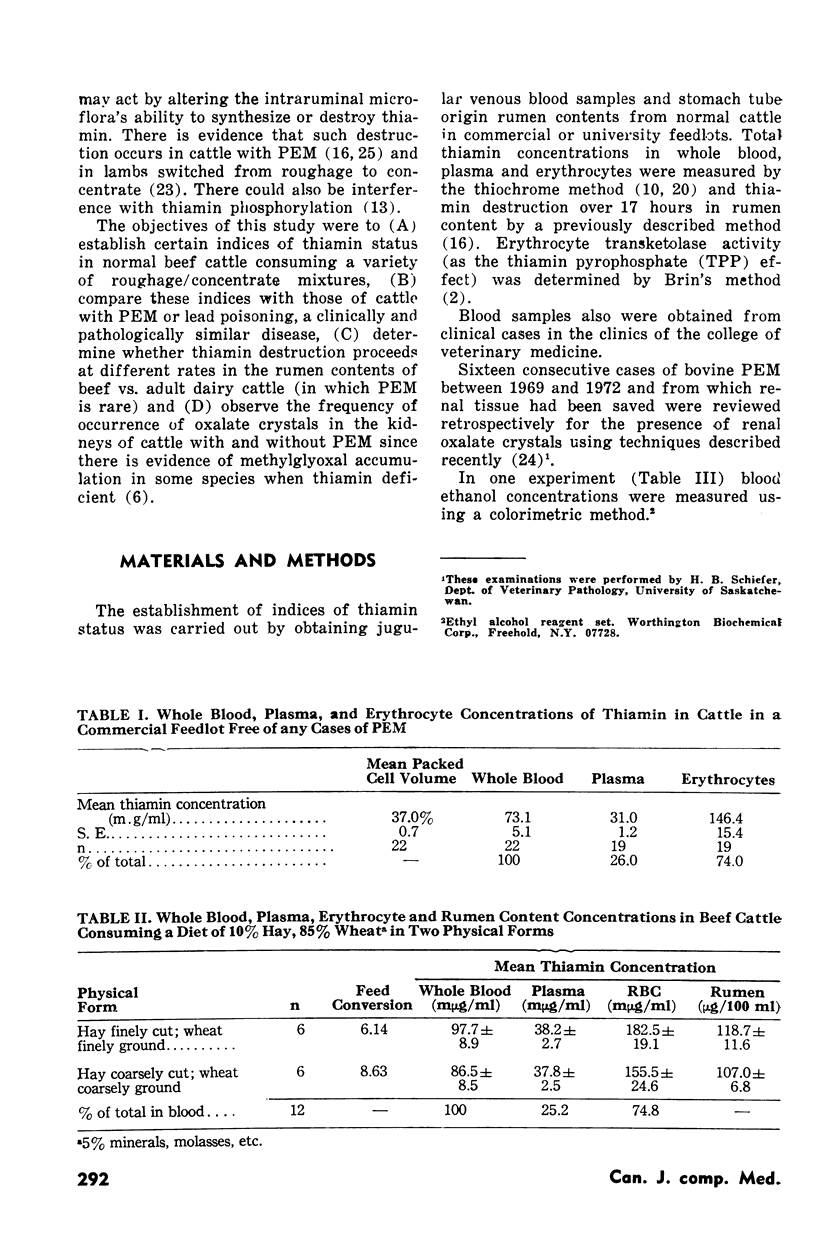Abstract
The thiamin status (thiamin concentration in whole blood, plasma, and erythrocytes; erythrocyte transketolase activity) of normal cattle consuming varying diets did not differ from that of cattle with polioencephalomalacia or lead poisoning. Dairy cattle had higher ruminal content of thiamin and lower thiamin destroying activity than did beef cattle. Renal oxalosis was no more frequent in cattle which had polioencephalomalacia than in postnatal calves. In normal beef cattle, approximately 75% of total blood thiamin is in erythrocytes and the remainder in plasma.
Full text
PDF




Selected References
These references are in PubMed. This may not be the complete list of references from this article.
- BRIN M. THE ANTITHIAMINE EFFECTS OF AMPROLIUM IN RATS ON TISSUE TRANSKETOLASE ACTIVITY. Toxicol Appl Pharmacol. 1964 Jul;6:454–458. doi: 10.1016/s0041-008x(64)80012-0. [DOI] [PubMed] [Google Scholar]
- Buchanan-Smith J. G., Horney F. D., Usborne W. R., Burgess T. D. Effects of feeding a zero- or high-roughage diet to cattle upon adipose tissue lipogenesis. Can J Physiol Pharmacol. 1973 Jul;51(7):532–538. doi: 10.1139/y73-078. [DOI] [PubMed] [Google Scholar]
- Cooper J. R., Pincus J. H., Itokawa Y., Piros K. Experience with phosphoryl transferase inhibition in subacute necrotizing encephalomyelopathy. N Engl J Med. 1970 Oct 8;283(15):793–795. doi: 10.1056/NEJM197010082831506. [DOI] [PubMed] [Google Scholar]
- Houser H. B., Myint T., Weir D. R. Estimation of red blood cell thiamine concentration from whole blood and serum thiamine by adjustment for hematocrit. Am J Clin Nutr. 1967 Jan;20(1):46–51. doi: 10.1093/ajcn/20.1.46. [DOI] [PubMed] [Google Scholar]
- July J. R., Netto L. P., Jordão N. T., Sobrinho A. S. Diarréia a vírus dos camundongos lactentes. aspectos ultraestruturais do epitélio intestinal. Arq Inst Biol (Sao Paulo) 1975;42:293–295. [PubMed] [Google Scholar]
- King J. S., Jr, Lehner N. D. Effects of some compounds on urinary oxalate excretion by the human and the squirrel monkey. Invest Urol. 1971 Jan;8(4):391–398. [PubMed] [Google Scholar]
- Loew F. M. A thiamin-responsive polioencephalomalacia in tropicaland nontropical livestock production systems-1. World Rev Nutr Diet. 1975;20:168–183. [PubMed] [Google Scholar]
- Loew F. M., Dunlop R. H. Blood thiamin concentrations in bovine polioencephalomalacia. Can J Comp Med. 1972 Oct;36(4):345–347. [PMC free article] [PubMed] [Google Scholar]
- Loew F. M., Dunlop R. H., Christian R. G. Biochemical aspects of an outbreak of bovine polioencephalomalacia. Can Vet J. 1970 Mar;11(3):57–61. [PMC free article] [PubMed] [Google Scholar]
- Loew F. M., Dunlop R. H. Induction of thiamine inadequacy and polioencephalomalacia in adult sheep with amprolium. Am J Vet Res. 1972 Nov;33(11):2195–2205. [PubMed] [Google Scholar]
- Loew F. M. Letter: Possible animal model of subacute necrotizing (Leigh's) encephalomyelopathy. J Pediatr. 1974 Dec;85(6):876–877. doi: 10.1016/s0022-3476(74)80371-9. [DOI] [PubMed] [Google Scholar]
- MYINT T., HOUSER H. B. THE DETERMINATION OF THIAMINE IN SMALL AMOUNTS OF WHOLE BLOOD AND SERUM BY A SIMPLIFIED THIOCHROME METHOD. Clin Chem. 1965 Jun;11:617–623. [PubMed] [Google Scholar]
- Morgan K. T. Amprolium poisoning of preruminant lambs. An ultrastructural study of the cerebral malacia and the nature of the inflammatory response. J Pathol. 1974 Apr;112(4):229–236. doi: 10.1002/path.1711120407. [DOI] [PubMed] [Google Scholar]
- Pill A. H. Evidence of thiamine deficiency in calves affected with cerebrocortical necrosis. Vet Rec. 1967 Aug 19;81(8):178–181. doi: 10.1136/vr.81.8.178. [DOI] [PubMed] [Google Scholar]
- Roberts G. W., Boyd J. W. Cerebrocortical necrosis in ruminants. Occurrence of thiaminase in the gut of normal and affected animals and its effect on thiamine status. J Comp Pathol. 1974 Jul;84(3):365–374. doi: 10.1016/0021-9975(74)90010-3. [DOI] [PubMed] [Google Scholar]
- Schiefer B., Moffatt R. E. Bovine abortion associated with renal oxalosis in the fetus. Can Vet J. 1974 Mar;15(3):57–65. [PMC free article] [PubMed] [Google Scholar]
- Takasaki E. The urinary excretion of oxalic acid in vitamin B1 deficient rats. Invest Urol. 1969 Sep;7(2):150–153. [PubMed] [Google Scholar]
- VAN EYS J., JUDGE M. A., JUDD J., HILL W., BOZIAN R. C., ABRAHAMS S. A reinvestigation of methylglyoxal accumulation in thiamine deficiency. J Nutr. 1962 Apr;76:375–384. doi: 10.1093/jn/76.4.375. [DOI] [PubMed] [Google Scholar]


